Through its data storage innovations, Huawei is aiming for greener data centers with its “3+1” sustainability strategy as it reinforces the advantages of its OceanStor Dorado all-flash storage products, Huawei Technologies Philippines Enterprise Business CTO and IT director Arnold Alvarez said in an exclusive interview with Newsbytes.PH.

Huawei OceanStor Dorado is a product line of all-flash storage systems designed for enterprise use, delivering a higher level of performance and reliability, and accelerated by intelligent proprietary algorithms. To achieve a lower price tag versus the competition, Huawei has put research and development at the core of its planning and manufacturing stages.
In fact, Huawei’s R&D expenditure reach a new high in 2021 to $20.1 billion, expanding its previous 10% allotment sourced from its total revenue, to 22.4% going back to R&D. On a global scale, Huawei is backed by over 100,000 R&D employees, a 54.8% lion’s share of its total staff pool. These efforts, according to Alvarez, translates to more scalable and resilient, faster and secure, and more intelligent storage systems.
“Given Huawei’s focus on R&D, Huawei continues to make advances in the fundamental theories on pushing algorithms ever closer to the theoretical Shannon limit, helping Huawei to substantially simplify the design of transceivers, thus enabling the systems to be more cost effective while driving optimum performance,” he explained.
OceanStor Dorado is powered by five built-in proprietary Huawei intelligent chips that run an end-to-end service acceleration platform, tripling performance and maximizing resource utilization. Since Huawei designs and manufactures its own internal components, it is also able to make important adjustments needed within the interoperating components, ensuring optimum output from the entirety of the storage system.
“Huawei purposely designed the OceanStor Dorado v6 to utilize the industry’s leading-edge Arm-based CPU, Kunpeng 920. Utilizing cutting-edge 7 nm processes, the CPU was independently designed by Huawei based on the Arm architecture license. Processor performance is significantly improved by optimizing branch prediction algorithms, increasing the number of execution units, and improving the memory subsystem architecture,” added Alvarez.
A report on the data storage market conducted by IndustryARC shows that its value is expected to hit $4.2 billion in 2026, driven by growing adoption of centralized and micro mobile data centres. Beyond the rise of cloud technology for enterprise storage use cases, external data storage devices are also expected to grow amid the market rally.
“It is clear that flash no longer just relates to sensitive workloads. It’s a more efficient medium that can handle high throughput requirements, move large data sets faster, and create infrastructure that draws less power, is more compact, takes up less floor space, and is more reliable. Having said this, the Dorado v6 storage systems come with several models. It can cater to any type of organization, from the smallest to the biggest,” he remarked.
Alvarez added that as storage systems become more intelligent and offer higher performance and reliability, end-to-end access latency of these same storage systems has also been radically shortened. With requirements and expectations on IT infrastructure on the rise, choosing a proper storage system becomes a crucial part in building a modern IT infrastructure.
In conventional enterprise storage systems, write amplification is a common pain point that the end-users are hoping to be addressed by their providers. This phenomenon takes place when the original amount of write is multiplied into a disproportional amount during the data writing process.
To offset write amplification, Huawei has an SSD-optimized design and disk-controller collaboration technology in place – allowing storage controllers to detect data layouts in SSDs real-time, and synchronizing the data between controllers and SSDs to avoid garbage collection.
“The internal algorithm of Dorado does the small blocks combination then it writes a big chunk into the storage system at one time. This results into less write which translates to less write amplification,” clarified Alvarez.
The Huawei OceanStor Dorado roster is subsumed by an overarching green strategy that the company announced in May at the Huawei Innovative Data Infrastructure Forum 2022 in Munich, Germany. In a nutshell, the campaign hopes to cut down the average energy consumption levels of enterprise data storage appliances through the use of SSDs, consolidating multiple storage systems, and reducing data duplication.
“In terms of product usage, Huawei’s Artificial Intelligence for IT Operations (AIOps) enables on-demand storage resource allocation and use. Huawei also mitigates the environmental impact of its products by maximizing product recycling through a continuously improved global recycling system,” he remarked.
“Looking to the future, green development will continue to be a long-term goal for Huawei. It plans to continue helping data centers go green by enabling industrial digital transformation with its innovative technologies,” Alvarez concluded.




